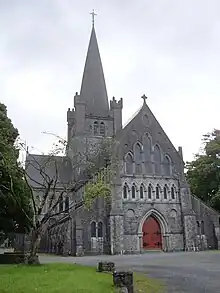The Earl of Mayo | |
|---|---|
 | |
| Archbishop of Tuam | |
| In office 1782–1794 | |
| Preceded by | Jemmett Browne |
| Succeeded by | William Beresford |
| Bishop of Ferns and Leighlin | |
| In office 1772–1782 | |
| Preceded by | Edward Young |
| Succeeded by | Walter Cope |
| Dean of Dromore | |
| In office 1772–1772 | |
| Preceded by | Walter Cope |
| Succeeded by | Raphael Walsh |
| Dean of Killaloe | |
| In office 1768–1772 | |
| Preceded by | William Henry |
| Succeeded by | William Pery |
| Personal details | |
| Born | Joseph Deane Bourke 1736 |
| Died | 20 August 1794 (aged 57–58) Kilbeggan, County Westmeath, Ireland |
| Nationality | Irish |
| Spouse |
Elizabeth Meade (m. 1760) |
| Children | |
| Parents |
|
Joseph Deane Bourke, 3rd Earl of Mayo (English: /bɜːrk/; BURK; 1736 – 20 August 1794) was an Irish peer and cleric who held several high offices in the Church of Ireland including Bishop of Ferns and Leighlin (1772–82) and Archbishop of Tuam (1782–94).
Family
Bourke was the second son of John Bourke, 1st Earl of Mayo and Mary Deane. In 1760, he married Elizabeth Meade, the daughter of Richard Meade, 3rd Baronet and Catherine Prittie. They had four sons: John Bourke, 4th Earl of Mayo, Richard, Joseph, and George, and six daughters: Catherine, Mary-Elizabeth, Mary-Anne, Charlotte, Louisa, and Theodosia-Eleanor.[1] Theodosia's son, Matthew Hale, was the first Bishop of Perth and then the Bishop of Brisbane.
Ecclesiastical career
Prior to his elevation to the episcopate, Bourke's earlier ecclesiastical appointments were Prebendary of Armagh (1760–1768);[2] Dean of Killaloe (1768–1772), Rector of Kilskyre, near Kells, County Meath (1769–1772);[3] and Dean of Dromore (1772).[4]
He was nominated as the Bishop of Ferns and Leighlin on 7 September 1772 and appointed by letters patent on 19 September 1772.[5][6] He was consecrated at St. Thomas's Church, Dublin on 11 October 1772; the principal consecrator was John Cradock, Archbishop of Dublin, and the principal co-consecrators were Charles Jackson, Bishop of Kildare and William Newcome, Bishop of Dromore.[5][6]
Ten years later, he was translated to the Archbishopric of Tuam by letters patent on 8 August 1782 and made a member of the Privy Council of Ireland.[7][8] On the death in 1792 of his brother, John Bourke, 2nd Earl of Mayo, he succeeded as the 3rd Earl of Mayo.[1]
He died at Kilbeggan in County Westmeath on 20 August 1794, and was interred in the burying ground of his family near Naas, County Kildare.[7]
Arms
 |
|
References
- 1 2 Burke 1882, A General and Heraldic Dictionary of the Peerage and Baronetage of the British Empire, vol. 2, pp. 156–157.
- ↑ Cotton 1849, The Province of Ulster, p. 53.
- ↑ Cotton 1851, The Province of Munster, p. 479.
- ↑ Cotton 1849, The Province of Ulster, p. 294.
- 1 2 Cotton 1850, The Province of Connaught, p. 342.
- 1 2 Fryde et al. 1986, Handbook of British Chronology, p. 394.
- 1 2 Cotton 1850, The Province of Connaught, p. 18.
- ↑ Fryde et al. 1986, Handbook of British Chronology, p. 406.
- ↑ Mosley, Charles, ed. (2003). Burke's Peerage, Baronetage & Knighthood (107 ed.). Burke's Peerage & Gentry. pp. 2653–2655. ISBN 0-9711966-2-1.
- ↑ Burke, Bernard (1884). The general armory of England, Scotland, Ireland, and Wales; comprising a registry of armorial bearings from the earliest to the present time. University of California Libraries. London : Harrison & sons.
Bibliography
- Burke, John (1882). A General and Heraldic Dictionary of the Peerage and Baronetage of the British Empire. Vol. 2 (4th ed.). London: Henry Colburn and Richard Bentley.
- Cotton, Henry (1851). The Province of Munster. Fasti Ecclesiae Hiberniae: The Succession of the Prelates and Members of the Cathedral Bodies of Ireland. Vol. 1 (2nd ed.). Dublin: Hodges and Smith.
- Cotton, Henry (1848). The Province of Leinster. Fasti Ecclesiae Hiberniae: The Succession of the Prelates and Members of the Cathedral Bodies of Ireland. Vol. 2. Dublin: Hodges and Smith.
- Cotton, Henry (1849). The Province of Ulster. Fasti Ecclesiae Hiberniae: The Succession of the Prelates and Members of the Cathedral Bodies of Ireland. Vol. 3. Dublin: Hodges and Smith.
- Cotton, Henry (1850). The Province of Connaught. Fasti Ecclesiae Hiberniae: The Succession of the Prelates and Members of the Cathedral Bodies of Ireland. Vol. 4. Dublin: Hodges and Smith.
- Fryde, E. B.; Greenway, D. E.; Porter, S.; Roy, I., eds. (1986). Handbook of British Chronology (3rd, reprinted 2003 ed.). Cambridge: Cambridge University Press. ISBN 0-521-56350-X.
External links
- Joseph Deane Bourke, 3rd Earl of Mayo (1740?–1794), Archbishop of Tuam (National Portrait Gallery)
